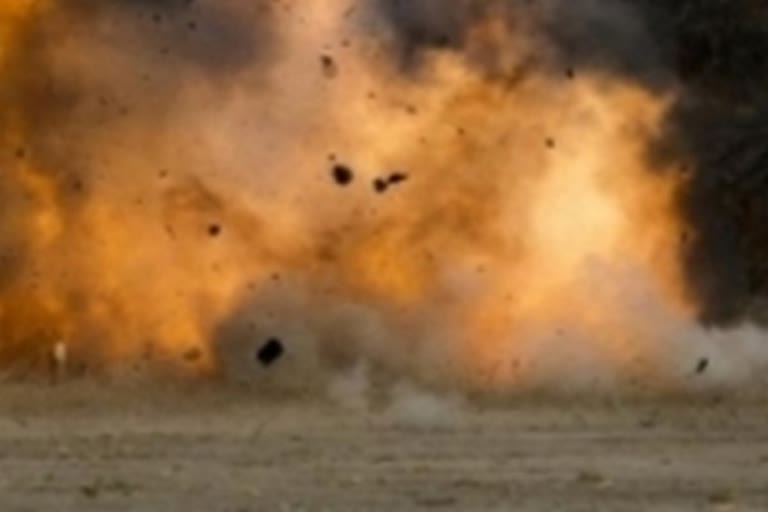ಮಾಸ್ಕೋ: ರಷ್ಯಾ ನಡೆಸಿದ ಮಿಲಿಟರಿ ಪ್ರಾಯೋಗಿಕ ಪರೀಕ್ಷೆ ವೇಳೆ ಸಿಡಿತಲೆಯೊಂದು ಆಕಸ್ಮಾತಾಗಿ ಸ್ಫೋಟಗೊಂಡು ವಿಕಿರಣ ಸೋರಿಕೆಯಾಗಿದ್ದು, ಪರಿಸ್ಥಿತಿ ಸದ್ಯ ತಹಬದಿಗೆ ಬಂದಿದ್ದರೂ ಅಲ್ಲಿನ ನಿವಾಸಿಗಳು ವಿಷಕಾರಿ ಪರಿಣಾಮ ತಡೆಯುವ ಔಷಧಗಳ ಮೊರೆ ಹೋಗಿದ್ದಾರೆ.
ರಷ್ಯಾದ ನ್ಯುನೋಕ್ಸ ಗ್ರಾಮದ ಮಿಲಿಟರಿ ಪರೀಕ್ಷಾ ಸ್ಥಳದಲ್ಲಿ ನಡೆದ ಈ ಘಟನೆಯಲ್ಲಿ ಇಬ್ಬರು ತಜ್ಞರು ಮೃತಪಟ್ಟಿದ್ದಾರೆ. ಇನ್ನೂ ಆರು ಮಂದಿ ತೀವ್ರ ಗಾಯಗೊಂಡಿದ್ದಾರೆ ಎಂದು ರಷ್ಯಾದ ಪತ್ರಿಕೆಗಳು ವರದಿ ಮಾಡಿವೆ.
ಅಲ್ಲಿನ ಪರಿಸರ ಕಾರ್ಯಕರ್ತರು ರಷ್ಯಾದ ತುರ್ತು ಪರಿಸ್ಥಿತಿಗಳ ಸಚಿವಾಲಯಕ್ಕೆ ದತ್ತಾಂಶಗಳನ್ನು ಸಲ್ಲಿಸಿದ್ದು, ವಿಕಿರಣ ಮಟ್ಟವು ಸರಾಸರಿಗಿಂತ ಶೇ.20ರಷ್ಟು ಹೆಚ್ಚಾಗಿರುವುದಾಗಿ ಆರೋಪಿಸಿದ್ದಾರೆ. ಅಧಿಕಾರಿಗಳು ವಿಕಿರಣ ಮಟ್ಟ ಹೆಚ್ಚಿದ್ದರೂಸಿರುವುದನ್ನು ಏಕೆ ವರದಿ ಮಾಡಲಿಲ್ಲ ಎಂದು ಪ್ರಶ್ನಿಸಿದ್ದಾರೆ. ಈಗಾಗಲೇ ಅಲ್ಲಿನ ವಿಕಿರಣ ಮಟ್ಟ ಸಾಮಾನ್ಯ ಸ್ಥಿತಿಗೆ ಮರಳಿದ್ದು. ಇದು ಅಧಿಕಾರಿಗಳ ಲೋಪದಿಂದಾಗಿ ಈ ಅನಾಹುತ ಜರುಗಿದೆ.
ಅಲ್ಲಿನ ಜನರು ಹಾನಿಕಾರಕ ವಿಕಿರಣಗಳಿಂದ ರಕ್ಷಣೆ ಪಡೆಯಲು ಅಯೋಡಿನ್ ಕ್ಯಾಪ್ಸುಲ್ಗಳ ಮೊರೆಹೋಗಿದ್ದಾರೆ ಎಂದು ಮಾಧ್ಯಮಗಳು ವರದಿ ಮಾಡಿವೆ. ಗಾಯಗೊಂಡು ಆಸ್ಪತ್ರೆಯಲ್ಲಿ ಚಿಕಿತ್ಸೆ ಪಡೆಯುತ್ತಿರುವ ಮಹಿಳೆಗೆ ಆಸ್ಪತ್ರೆಯಲ್ಲಿ ಅಯೋಡಿನ್ ಕ್ಯಾಪ್ಸುಲ್ಗಳನ್ನು ತೆಗೆದುಕೊಳ್ಳುವಂತೆ ಸೂಚಿಸಲಾಗಿದೆ.
Intro:Body:
deadly explosion at a military test site in Russia this week reportedly led residents to scramble for medicine to safeguard against some of the toxic effects of radiation poisoning.
On Thursday, a massive blast near Nyonoksa, a village about 29 miles west of Severodvinsk in Russia's northwestern Arkhangelsk province, killed at least two specialists, according the state-run Tass Russian News Agency. At least six more people were injured, the agency reported, several with life-threatening wounds.
The official source of the explosion, as reported by RIA Novosti, was a liquid-propelled rocket engine. That alone, however, would not explain why officials in Severodvinsk reported heightened radiation levels. The environmental activist group Greenpeace pointed to data from the Russian Ministry of Emergency Situations allegedly showing a spike some 20 times above average. Those levels have since returned to normal but, on Thursday, residents were still taking precautions.
Local media outlet 29 spoke with several pharmacists who reported customers were seeking iodine, which can protect the thyroid from absorbing harmful radiation. Some stores reported completely running out of supplies.
A woman who claimed to work at a hospital where the injured were being treated said patients were being advised to close their windows and take iodine, according to the Russian news site Lenta.
Authorities in Arkhangelsk have been downplaying reports of radiation contamination, with the region's official press service saying Thursday that testing showed radiation levels were "within normal limits." Following two press meetings of the local emergency commission, the situation was described as being "under control."
"Air, soil [and] water samples were taken and an assessment of the radiation background in Severodvinsk and its surroundings was carried out," Alexei Gromov, an expert from the St. Petersburg Institute of Radiation Hygiene, told the regional press service. "The check covered several settlements. None of them exceeded the normal level of radiation background."
Arkhangelsk's chief sanitary officer, Roman Buzinov, added that, "the system of control and analytical measures was carried out in full. There are no grounds for concern for the life and health of northerners."
Still, few details have been made public about the circumstances surrounding the incident, which coincided with an explosion at a Siberian arms depot. It was the second such event in the wildfire-ravaged region in a week, and followed an accident last month aboard an allegedly nuclear-powered deep-sea submersible that killed 14.
Details about the submarine incident were labeled "absolutely classified" by the Kremlin.
There were already concerns about a nuclear incident in northern Russia before this week's explosion, thanks to an upcoming sea journey by the Akademik Lomonosov, a massive floating power unit with twin nuclear reactors. The unique vessel has been criticized by Greenpeace as a "nuclear Titanic" and "Chernobyl on ice."
Numerous Russian news sites report that Nyonoksa is home to a naval testing site where the explosion may have originated. Tass cited an unnamed source as saying the blast may have happened on a barge or a ship.
The Independent Barents Observer further noted on Friday that, at the time of the blast, Serebryanka, a ship known to carry nuclear fuel and other radioactive material, was anchored just a few nautical miles away and remained the following day until slowly taking off.
The outlet reported that Serebryanka was also spotted sailing west of Novaya Zemlya in November 201, when Russia was allegedly conducting a test of its nuclear-powered cruise missile Burevestnik. Among the advanced weapons unveiled by Putin in March 2017, the missile is reportedly capable of dodging even the most state-of-the-art defense systems.
Conclusion:




